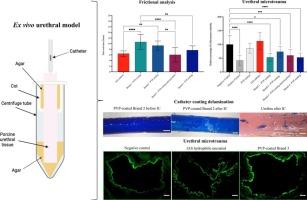An ex vivo porcine urethral model for investigating intermittent catheter-associated urethral microtrauma
IF 7.9
2区 材料科学
Q1 MATERIALS SCIENCE, MULTIDISCIPLINARY
引用次数: 0
Abstract
Catheter-associated urethral microtrauma is a significant complication of intermittent catheterisation, compromising patient quality of life (QOL) and increasing urinary tract infection risk. Current research is hindered by the lack of robust physiological models to evaluate the mechanical interactions between catheter materials and urethral tissue during intermittent catheterisation. This study introduces the first ex vivo porcine urethral model to investigate tribological performance and material-tissue interactions during intermittent catheter (IC) use, enabling more informed catheter design. We examined four commercial hydrophilic polyvinylpyrrolidone (PVP)-coated ICs and a coating-free integrated amphiphilic surfactant (IAS) IC. ICs were inserted into porcine urethras using a texture analyser, held for two minutes, and withdrawn while measuring force and work done. Post-catheterisation, urethras were examined for microtrauma. Three of four PVP-coated catheters required significantly greater withdrawal force compared to the IAS catheter, correlating with increased urethral transitional membrane damage post-catheterisation. Ex vivo findings suggest that IAS catheters may lower the risk of complications compared with PVP-coated catheters in intermittent catheterisation. This study provides a new platform for comprehensive evaluation of IC-tissue interactions. It underscores the importance of tribological design in medical devices, aiding future innovation in device design and ultimately improve the QOL of patients undergoing intermittent catheterisation.

研究间歇性导尿管相关尿道微创伤的猪离体尿道模型
导尿管相关尿道微创伤是间歇性导尿的重要并发症,影响患者的生活质量(QOL)并增加尿路感染的风险。目前的研究受阻于缺乏可靠的生理模型来评估间歇导尿期间导管材料与尿道组织之间的机械相互作用。本研究引入了第一个离体猪尿道模型,以研究间歇性导管(IC)使用期间的摩擦学性能和材料-组织相互作用,从而使导管设计更加知情。我们研究了四种商业亲水性聚乙烯吡罗烷酮(PVP)涂层集成电路和一种无涂层集成两亲性表面活性剂(IAS)集成电路。使用质地分析仪将集成电路插入猪尿道,保持两分钟,并在测量力和做功时取出。导尿后,检查尿道是否有微创伤。与IAS导管相比,四分之三的pvp涂层导管需要更大的拔管力,这与置管后尿道移行膜损伤增加有关。体外研究结果表明,与pvp涂层导管相比,IAS导管在间歇置管中可能降低并发症的风险。本研究为ic -组织相互作用的综合评价提供了新的平台。它强调了医疗器械中摩擦学设计的重要性,有助于器械设计的未来创新,并最终改善间歇导尿患者的生活质量。
本文章由计算机程序翻译,如有差异,请以英文原文为准。
求助全文
约1分钟内获得全文
求助全文
来源期刊

Materials & Design
Engineering-Mechanical Engineering
CiteScore
14.30
自引率
7.10%
发文量
1028
审稿时长
85 days
期刊介绍:
Materials and Design is a multi-disciplinary journal that publishes original research reports, review articles, and express communications. The journal focuses on studying the structure and properties of inorganic and organic materials, advancements in synthesis, processing, characterization, and testing, the design of materials and engineering systems, and their applications in technology. It aims to bring together various aspects of materials science, engineering, physics, and chemistry.
The journal explores themes ranging from materials to design and aims to reveal the connections between natural and artificial materials, as well as experiment and modeling. Manuscripts submitted to Materials and Design should contain elements of discovery and surprise, as they often contribute new insights into the architecture and function of matter.
 求助内容:
求助内容: 应助结果提醒方式:
应助结果提醒方式:


